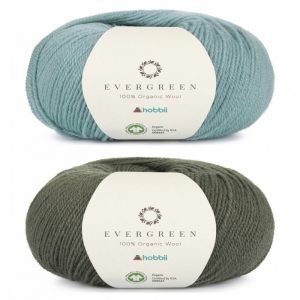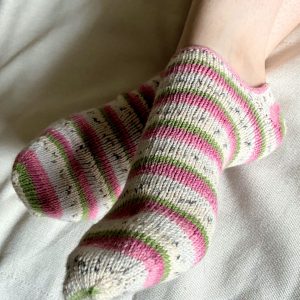Do you want to knit or crochet a garment, but don’t know what yarn to use? This comprehensive guide will teach you everything (at least almost) you need to know about choosing the best yarn for your next sweater project.
1. What Kind of Sweater You Would Like to Make
The most important thing in selecting a suitable yarn for your next sweater or cardigan project is to determine what kind of sweater you would like to make.
Are you looking for a light and airy summer cardigan, or a cozy and warm winter sweater? Do you want a garment that’s meant for everyday use and easy to care for or maybe a luxurious cardigan you use every now and then and don’t mind handwashing?
If you have already selected a pattern take a look at what kind of yarn the designer used and if you want to be on the safe side select a similar one. Yarnsub.com is a great website that helps you to find yarns with similar qualities.
Once you know what kind of garment you want to make, it will be much easier to select the right yarn.
2. Fiber Content
The next thing you have to think about is the fiber content. Below I have listed the most common fibers that are used to knit sweaters. Each of these fibers has different properties that can make it more or less suitable for your sweater.
I’m a huge fan of natural fibers because of their superior properties and they are also usually more environmentally friendly. Even though I wouldn’t personally use yarns made of synthetic fibers I have still listed them below because they can be a good choice if you are on a really tight budget.
2.1 Animal Fibers
2.1.1 Wool (Lamb)
Lambswool is probably the most common fiber used in sweaters and for a good reason: It’s warm during the winters but can also keep you cool during the summers. Wool is also breathable, naturally dirt-resistant, and very pleasant to knit.

There are numerous different lamb breeds that provide different qualities of wool. For example, merino wool is very fine and soft while the wool produced by Finnsheep is coarse and might feel itchy if you have sensitive skin. However, it is much more durable than finer wool.
To put it short:
- If you have sensitive skin go for softer wools such as KnitPicks Twill or Mayflower Easy Care.
- If you want to make a warm sweater for your hikes that can take hard use choose wool from breeds originating from Finland or Iceland such as Lettlopi for instance. If you want to learn more about this subject here’s a great article about different lamb breeds and what kind of wool they produce.
2.1.2 Silk
Silk is a luxurious natural fiber produced by silkworms. It has a beautiful sheen and it’s very smooth which makes it pleasant to wear next to the skin. Silk also takes dye very well so you can find it in many amazingly deep colors.
Silk is quite delicate as well as somewhat expensive. At best it’s in a sweater project when blended with other natural fibers such as merino wool. Nice silk and merino blend yarns are for instance KnitPicks Gloss DK and Malabrigo Silky Merino.
2.1.3 Alpaca
The wool produced by alpacas is very soft and has a lot of drape. It’s often used in luxury garments. It is not bouncy as wool is so it’s not suitable for ribbed sweaters. I love to use it for lace though. Some good quality Alpaca yarns are for instance KnitPicks Wonderfluff and Juniper Moon Farm Moonshine that has wool, silk and alpaca.
2.1.4 Cashmere
Cashmere is wool produced by cashmere goats. The fiber is very fine and soft which makes it luxurious to wear. The yarn is quite expensive and thus it’s often used in high-end sweaters. Some nice cashmere yarns are for instance Lang Yarns Cashmere Premium, Jade Sapphire Mongolian Cashmere 8-Ply and Rowan Pure Cashmere.
2.2 Plant Fibers
2.2.1 Cotton
Cotton is a natural plant-based fiber that breathes well and is very absorbent. Cotton yarns such as Hobbii Rainbow are perfect for summer garments and are also a great choice for those who are allergic to wool. It’s also easy to care for since you can just throw it in the washing machine.
The downside of cotton is that it doesn’t insulate as well as and is not as bouncy as wool which makes it a little bit unpleasant to knit. I find it also quite heavy.
2.2.2 Linen
Linen is a plant-based fiber that’s derived from the flax plant. Like cotton, it’s also quite absorbent and breathes well which makes it perfect for summer garments. It might feel quite rough at first but it will soften with each wash. One of my favorite linen yarns is the Katia Lino.
Linen is also a bit difficult to work but I love it when it’s blended with cotton and viscose. Some nice yarn blends are Rowan Creative Linen, BC Garn Allino and KnitPicks Lindy Chain.
2.2.3 Bamboo
Yarns that contain bamboo as Hobbii Rainbow Bamboo or Scheepjes Bamboo Soft DK are soft, breathable, and has a lot of drape and a bit of a sheen to it. The downside of bamboo is that it can stretch more easily.
2.3 Synthetic Fibers
2.3.1 Acrylic
Acrylic is a man-made fiber and is often used as a cheaper alternative to wool or cotton. Acrylic yarns such as KnitPicks Brava Worsted, Hobbii Amigo and Stylecraft Special DK feel soft and are easy to care for but they don’t breathe and pill very easily.
Personally, I wouldn’t use it for garments since I prefer my handmade items to look good for a long time.
2.3.2 Polyester
Polyester is another man-made fiber that’s often used in cheaper garments. Polyester yarns such as Hobbii Honey Bunny and Lion Brand Feels Like Butta are quite strong and don’t wrinkle easily. However, polyester doesn’t breathe and can feel quite synthetic.
2.4 Blends
When you blend two fibers with each other you can often get the best of both worlds. For example, when you blend wool with silk you get a yarn that’s strong, has a beautiful sheen, and is pleasant to knit with. Similarly blending cotton and wool can get you a yarn that is nicer to wear in hot weather than pure wool but more pleasant to work with than pure cotton.

3. Care Instructions
When you’re choosing your yarn it’s important to think about how you will care for your finished garment. So before making the purchase decision check the label of the yarn to see whether it can be machine washed or not.
Generally cotton and acrylic are the easiest to care for since you can just throw them in the washing machine.
In the case of wool, you need to make a choice between a superwash and non-superwash wool.
- Superwash wool can be machine-washed and it resists felting. However, the manufacturing process is not particularly environmentally friendly and the wool loses in my opinion some of its best qualities and becomes less elastic and warm as well as water and dirt-resistant.
- Non-superwash wool needs to be hand-washed but it has all the great qualities that make wool such a popular fiber for sweaters. Because it’s naturally dirt-resistant quite often just airing it out will be enough to make it feel fresh again. It’s also a more sustainable choice.
Silk and cashmere are the most delicate fibers and require special care. They are best hand-washed in cool water with a mild detergent.
4. Thickness of Yarn
The thickness of your yarn is also called the weight of the yarn. From thinnest to thickest the yarn weights are:
- Lace
- Fingering
- Sport
- Worsted
- Chunky
Usually, the yarn weight is stated on the label but if not you can use this chart to determine it.
Typically light sweaters meant for indoor use are made with fingering, sport, or DK weight yarn while heavier super warm sweaters are made with worsted weight or even thicker yarn. You can knit or crochet sweaters with lace weight yarn as well but be prepared to use a lot of hours for your project.
The thicker the yarn the fewer stitches you’ll need per inch and the faster your project will progress but the fabric will also be less drapey.
5. Yarn Construction
Yarns can be made of either single ply or multiple plies. Single-ply yarn is made of one strand of fiber while a multiple-ply yarn is made by twisting two or more strands of fiber together.
- Multiple-ply yarns are usually stronger and less prone to pilling. The tighter the twist the stronger the yarn will be.
- Single-ply yarns are not as strong but often have a nicer drape and soft and cozy feel. They can also be less expensive since they require less processing.
If there’s some kind of stitch pattern such as lace or cables on your sweater make sure to select a yarn that shows it beautifully. For instance, if you knit a cabled sweater with single-ply yarn the cables look a lot flatter if you would choose a yarn with let’s say at least 3 plies twisted fairly tightly around each other. If you are unsure if the yarn is suitable for textured knits check what kind of patterns the manufacturer or designers have made for the yarn.
6. Color
Color selection is completely up to your personal preference but there are a few things you might want to consider before buying a sweater’s quantity of yarn:
- If you are making the sweater for yourself consider what kind of colors you like to wear. I love yarns with bright colors and on yarn stores I’m always drawn to them. However, if I made a sweater with pink speckled yarn I probably wouldn’t wear it because my whole wardrobe mostly is black and blue. Going wild with colors is safer with accessories.
- Working with dark yarns can be hard if you have bad lighting.
- If you choose hand-dyed yarn make sure to buy enough for your project because it can be hard to find the exact same colorway again. Remember also to alternate skeins to avoid big differences in color within your garment.
7. Conclusion
That’s all that came to my mind! There are so many different types of yarns available that it can be overwhelming to choose just one for your sweater. I hope this guide has given you some ideas and helped you to make a decision.










